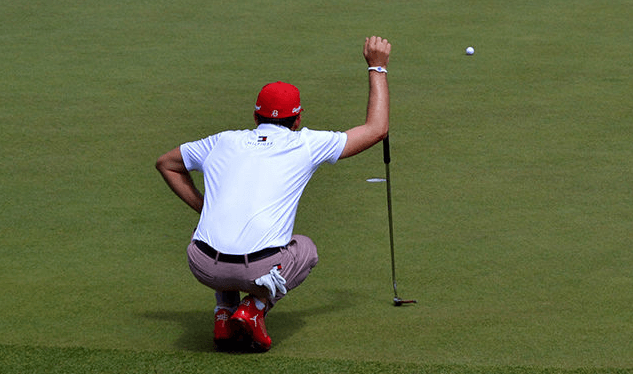
Have You Tried The Tour Player Putting Routine?
Next time you watch the PGA Tour on the TV, be sure to watch what a Tour player does before, during and after each putt. They’ll follow a very deliberate sequence. Putting is perhaps the time in golf that requires the most mental and emotional control, because you’re that much closer to the score that goes down on the card. The key (as with all my coaching), is to focus on “the process” and not the outcome.
In this article I’m going to talk you through the steps that a Tour player goes through before each putt.
Your putting routine
Your putting routine doesn’t have to follow this exactly (we all have our own individual style), but I’ve outlined the basic steps that a Tour player goes through before every putt. However you integrate this into your putting routine, make it the same, every time and make it fairly quick. The longer you stand over a putt, the longer you have to second guess yourself. Aaron Baddeley, for example, says his pre-shot routine for putting is 11 seconds, Sergio Garcia says his is 10 seconds. The goal is to make every putt feel the same, whether it’s to win a $10 game with your buddies or the club championship and maximize your chances of holing it.
1. Green reading
Tour players (together with their caddies) are very good at green reading. It’s extremely important to get better at this instead of guessing most of the time. On a basic level, always look for the low point on the green and most putts (unless it’s a multi-tiered green) will break towards that. Try to break longer putts into 3 and pay special attention to the last 3rd, where the ball will be slowing down and break more. In the Golf State of Mind Putting Program I go through this in more detail and include insight from Tour caddies.
2. Visualize
I like to start the visualization and feel stage of the routine from behind the putt, looking down the line between the ball marker and the hole. Standing with both your eyes and body facing the line of the putt (so you’re looking directly down the line), do your practice strokes and visualize the line the ball will take to the hole. I prefer this method to doing your practice strokes parallel to the ball to target line, as you can more easily see the line the ball needs to take and a spot the ball will roll over in the first 6 inches of the putt, so it’s fresh in your mind when you step into the putt.
Try to paint the line in your mind against the grass, feel the pace and see it roll into the hole with each practice stroke. Here your giving your subconscious the valuable information it needs to move your body and turn that image into reality.
3. AIM, AIM, AIM!
Alignment is arguably the most important thing in your putting set-up, so it requires due attention.
Now place the ball down. Still looking down the line, use the alignment line you’ve already marked on your ball (or if not, the logo) and make sure this is pointing exactly in the direction you need the ball to start rolling (the spot you picked out in step #2. Align the putter, square to “your spot”. This way, you’ll know the putter is perfectly square to your target line.
4. Where is your focus before the putt?
The trick to better putting is to hold the vision of the ball going into the hole, right up until you take the putter back. You need to “look and react” to the imagery, instead of thinking about what your body needs to do. Looking and reacting prevents conscious thought from interfering. Such thoughts could be anything to do with your technique, what the putt means for your score or second guessing the line.
Make this last part swift. Good putters feel like their eyes are still moving back towards the ball before they start their stroke. The more you stand over the ball, the more time there is for you to disconnect with the most important thing: the image of the line the ball will take to the hole.
5. Stay in the putt
Watch any Tour player and you’ll notice their head (and eyes) stay firmly fixed for at least a second or two after the ball has been hit. This ensures there’s no body movement (sway) and inconsistent contact with the ball.
6. Respond well
“I never missed a putt in my mind.” – Jack Nicklaus
In any round, you’re going to hit good putts that miss and bad putts that go in. That’s golf. One of the key differences between good and average players is how they react to misses. Don’t create tension ahead of the next shot by reacting poorly. If you stuck to your process, you hit a good putt whether it went in or not.
Put these steps into something you can follow. It’ll make you feel a lot more confident and take some of the pressure off.
Photo courtesy of Galatians Design


